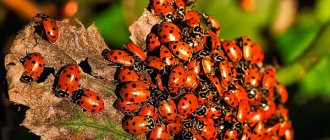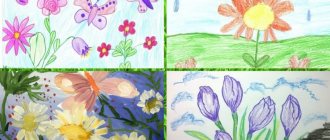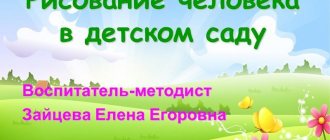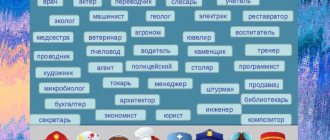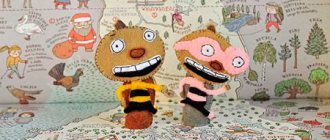We are pleased to welcome you to the website of the municipal budgetary preschool educational institution “Kindergarten of a combined type No. 134”
The municipal budgetary preschool educational institution "Kindergarten of a combined type No. 134" is a non-profit organization created by establishment to provide services in order to ensure the implementation of the powers of the municipal formation "City of Kursk" in the field of education provided for by the legislation of the Russian Federation. Direct educational activities are conducted in Russian.
The institution was registered on the basis of the order of the head of the Administration of the city of Kursk dated August 31, 1995 No. 840-r.
The founder of “MBDOU No. 134” is the Administration of the city of Kursk represented by the Education Committee of the city of Kursk, which carries out management in the field of education in the territory of the municipal formation “city of Kursk”, 305004, Kursk city, Radishcheva street, 103.
Chairman of the Education Committee of the city of Kursk Belkin Sergey Ivanovich. Telephone
Head of the preschool education department Angela Grigorievna Volshchukova. Telephone
Full name – municipal budgetary preschool educational institution “Kindergarten of a combined type No. 134”.
Abbreviated name – “MBDOU No. 134”
Type of municipal institution - budgetary.
Establishment status:
type – preschool educational institution;
type – combined type kindergarten.
Location (legal and actual address): 305048, Russian Federation, Kursk region, Kursk city, K. Vorobyova street, building 9.
Telephone
E-mail address
Internet site address: mdou134.ru
"MBDOU No. 134" operates on a five-day work week with days off: Saturday and Sunday. The duration of work at MBDOU No. 134 (duration of stay of children in groups) is 12 hours a day (from 7 a.m. to 7 p.m.).
The institution does not have representative offices or branches.
It does not provide additional paid educational services.
Head of MBDOU No. 134 - Demekhina Yulia Nikolaevna
1
NO to extremism!
The Path - Social video about our life:
For the sake of the future, say NO to extremism:
No extremism:
On June 22, an information campaign is being held to prevent falsification of Russian history.
Regional specialized exhibition of educational organizations “Spiritual and moral education of children and youth in the Kursk region”
About the launch of a hotline on immunoprophylaxis issues
will organize a hotline on immunoprophylaxis issues from April 12 to April 30, 2021
They will advise citizens on vaccination against measles, rubella, mumps, polio, pneumococcal and Haemophilus influenzae infections, tuberculosis, viral hepatitis B, diphtheria, whooping cough, tetanus and other vaccine-preventable infections, and will also provide explanations on the legal aspects of immunoprophylaxis in the Russian Federation and other topics of interest questions.
Consultations for citizens will be organized on weekdays from 10.00 to 17.00, on Fridays from 10.00 to 16.00, with a break from 13.00 to 14.00 by calling the Rospotrebnadzor Office for the Kursk Region:
— in Kursk;
— in Zheleznogorsk, Zheleznogorsk, Dmitrievsky, Khomutovsky, Fatezhsky districts - (47148) 2-46-49;
— in Lgovsky, Kurchatovsky, Konyshevsky, Rylsky, Glushkovsky, Korenevsky districts - (47140) 2-14-88;
-in Sudzhansky, Bolshesoldatsky, Belovsky, Medvensky, Oboyansky and Pristensky districts - (47143) 2-16-38;
- in Shchigrovsky, Cheremisinovsky, Timsky, Sovetsky, Kastorensky, Gorshechensky and Manturovo districts - (47145) 4-39-65.
The administration of the municipal budgetary preschool educational institution “Combined Kindergarten No. 134” informs about the purchase of the following means of prevention and protection against viral infection (including the new coronavirus infection Covid- 19 ) from budget funds:
— portable bactericidal recirculator – 2 pieces;
— non-contact thermometer – 2 pieces;
— disinfectants – 26 pieces.
Flu, coronavirus, other acute respiratory viral infections - a mask will help!
Influenza, coronavirus infection and other acute respiratory viral infections (ARVI)
Excursion as a means of environmental education for preschool children
This article is devoted to the study of excursions as a means of environmental education for preschool children. In the course of the study, the authors analyze the specific influence of the excursion on the cognitive ability of children, on the consolidation of the basic imperatives of environmental safety and nature-centrism in their value system.
Key words: educational process, pedagogical tool, education, ecology, ecosystem, system-activity approach, skill.
This article is devoted to the study of excursions as a means of environmental education of preschool children. In the course of the study, the authors analyze the specifics of the impact of the excursion on the cognitive ability of children, on the consolidation of the main imperatives of environmental safety, nature-centrism in their value system.
Key words: educational process, pedagogical tool, upbringing, ecology, ecosystem, system-activity approach, skill.
The excursion as a pedagogical tool began to gain popularity in domestic practice since the 1920s. In the 1980s it became widespread in many educational institutions and especially affected the specifics of education in regional preschool institutions, where there were a large number of natural monuments. Currently, in connection with the actualization of personality-oriented and system-activity approaches, the excursion has come to be understood as one of the most promising pedagogical means used within the framework of pedagogical education [3].
Environmental education is an important component of the learning process, which includes a number of means and methods for updating axiological information about individual elements of environmental culture. Environmental education for preschoolers today is gaining particular popularity based on three key positions: 1) state policy and the activities of the Federation Council; 2) orientation of preschool institutions towards environmental education; 3) domestic pedagogical traditions and innovations in the field of ecology education and bioethics [2].
An excursion as a pedagogical means of education should lay the foundations of curiosity and cognitive interest in children, and actualize important imperatives and value attractors in the key of bioethical behavior. In addition, the excursion, as a visual and practical method of implementing environmental education, will contribute to the development of preschoolers’ ability to appreciate the environment. This, in turn, will lay the foundations for a sense of belonging and sensory perception, and will also contribute to a more systematic development of personal learning outcomes with the further implementation of environmental education at school [1, p. 72].
A teacher conducting an excursion as part of environmental education will help preschoolers raise important questions of an axiological nature related to maintaining the ecological balance and determining the role of man and society in the natural world. This approach will become the foundation for understanding the concept of nature-centrism and mastering the human-society-nature system in its simplified form.
Thus, within the framework of preschool education, environmental education will make it possible to implement many pedagogical principles that are not available in the traditional type of relationship between the teacher and preschoolers. The main advantage of the excursion is its clarity, which allows us to reveal the significance of nature in human life. In addition, when a preschool institution is oriented towards the principles of environmental education, it is the excursion that can help the teacher implement the principle of practicality in his methodological activities [1, p. 73].
Continuing to form the value-humane attitude of a preschooler to nature, the teacher should remember that when conducting an excursion it is important not only to comply with all the formal and organizational foundations of the pedagogical process itself, but also to convey to children how closely nature and man are connected with each other, that man is this is not the “king of nature,” but only a small part of it. In this vein, the formation of preschoolers’ self-awareness is also reflected in the excursion factor [4, p. 80].
In fact, today, environmental knowledge is considered extremely useful for personal development. At the beginning of the formation in the mind of a preschooler of ideas about his role in the human-society-nature system, the key role is played by the motive and attitude that are set by the teacher and which are direct indicators of the child’s curiosity. Lack of interest in nature and the environment during an excursion can be resolved by selecting an individual approach for each preschooler.
As we have highlighted, an important place during the excursion is played by the motives and attitudes created by the teacher. Interpreted in a certain way, depending on external conditions, they determine many qualities in the emerging personality, influencing the emphasis of interests and hobbies. Thus, we can say that interest in nature, actualized in the motivational sphere, creates sustainable goal setting.
External factors for the manifestation of various forms of interest in nature are the child’s increased interest in species diversity, or at least in the signs of the ecosystem. In kindergarten, he can show interest in the form of questions asked to teachers and peers. In this case, the teacher should listen to the child and encourage his curiosity. The teacher should promote the development of curiosity in preschoolers, and pay special attention to this. Here, the main technique of the teacher should be motivation. All motives used by the teacher during the excursion can be divided into two types.
The first type is personal-psychological, completely dependent on the subjective qualities of the child, manifested during the excursion, his upbringing, character and mental state. We can also highlight the motive of striving to develop one’s knowledge through educational and cognitive activities, the motive of striving to educate, the motive expressed in the child’s desire to show himself among his peers, in the microsocium, the desire to consolidate his position, which consists in the need to assert himself, the motive of directly implementing cognitive activity and etc. Each of these motives manifests itself in its own way during the excursion [5, p. 211].
The second type of motives are various social motives that are formed under the influence of objective-subjective social factors on the child’s psyche. The influence of society on the formation of desires, through which the need of a preschooler is manifested in the need to fulfill a chosen (simulated) social role, the observance of which is expected of him by the environment. The excursion actualizes only the role of the teacher, therefore, the teacher must show by personal example what the axiological basis of environmental education is [5, p. 213].
The formation of a preschooler’s cognitive activity, his interests and his choice of activities in the future largely depend on the influence of the natural world. In fact, the formation of interest in nature occurs even in early preschool age under the influence of the first social groups that a person belongs to: the family, which largely shapes primary aspirations and interests; later, in older preschool age, relationships with friends are consolidated, which have a high social impact. psychological impact on the child. And the teacher, who is an authoritative figure of an adult, a formed personality in the eyes of a child, plays the role of a guide.
Conclusions . Thus, sensory development is carried out, on the basis of which thought processes arise, understanding is formed, and an aesthetic culture is formed. The main advantage of excursions is the opportunity to introduce children to objects and phenomena of living nature in a natural environment and make interesting observations. Properly organized, regular natural history excursions contribute to the formation of primary ideas about the relationships in nature, help children show curiosity and interest in the world around them, and contribute to the development of observation skills
Literature:
- Vysokova A. A., Chubova O. N. Organization of excursions into nature as a means of environmental education for preschool children // In the collection: Environmental safety, health and education. Collection of articles of the XII All-Russian Scientific and Practical Conference of Young Scientists, Postgraduates and Students. 2021. pp. 71–76.
- Goncharov A. S., Ivanov V. M. Psychological aspects of information warfare // In the collection: Current problems of information warfare in the modern world: challenges and threats for Russia and the Russian world. Materials of the International Scientific and Practical Conference. Under the general editorship of S. V. Bespalova. 2021, pp. 218–221.
- Goncharov A. S., Makarova O. S. Actual expansion of the zone of proximal development in the process of targeted learning // Young scientist. 2021. No. 32 (322). pp. 135–139.
- Minikhanova G. M. Excursion as a means of environmental education for children of senior preschool age // NovaUm.Ru. 2021. No. 24. pp. 80–81.
- Nikolaeva S.N. Theory and methodology of environmental education for children: Textbook. aid for students higher ped. textbook establishments. - Moscow: Publishing House, 2002. - 336 p.
Abstract of GCD on ecology in the senior group on the topic: Virtual excursion to the meadow
Ecology in the senior group. GCD
Abstract of GCD on ecology in the senior group. Virtual excursion to the meadow
Author: Irina Pavlovna Zholobova, teacher at MBDOU No. 22.
Goal: To form children’s ideas about the meadow. Program content: - to activate children’s ideas about the diversity of living organisms in the meadow; - continue to learn how to use a microscope; — teach children to compare different objects viewed under a microscope; - develop curiosity and attention; - develop interest in research, children’s interest in nature; - activate children's vocabulary with the following words and expressions: microscope, lens, eyepiece, stage, cells. Integration of educational areas: Speech development. Social and communicative development. Cognitive and research development. Preliminary work: Conversation about the meadow. Reading poems about the meadow, asking riddles about the plants of the meadow. A conversation about the purpose of a microscope, an examination of the components of a microscope, a conversation about the rules for using a microscope, an examination of onion skin cells and a butterfly wing. Materials and equipment: pictures of insects (mosquito, butterfly, bumblebee, bee), pictures of flowers (chamomile, dandelion, clover, bell), tables with images of insects and flowers visible under a microscope and numbers, corresponding riddles, glass slides with fragments of insects and plants, microscopes, presentation, picture meadow, number axes, pencils.
Move
- Guys, I know you are inquisitive!
You know how to solve riddles. (slide 1) Mom gave birth to a daughter From a beautiful flower. Nice, little one! The baby was an inch tall. If you've read the fairy tale, you know what the daughter's name was. (Thumbelina) Thumbelina invites you on an excursion to the meadow. (slide 2) - Let's say the magic words: “One, two, three, spin around. Find yourself in the meadow!” A path runs through the meadow, dives to the left, to the right. Everywhere you look there are flowers around, and knee-deep grass. I. Surikov “In the meadow” - Guys, we have come to the meadow. (slide 3) Have you been to a meadow or clearing? What plants grow in the meadow? Who lives there? Thumbelina is very smart and clever, she loves to ask riddles. Why does she have such a name? (answers) That's right, she is very small, her height is only 2.5 cm, and the riddles she prepared are just as small. Therefore, to see them we need a microscope. (Children sit at tables in pairs) Rules! Let's remember the safety rules: 1. Handle the slide carefully, only by the edges. 2. Place it on the microscope stage, 3. Set the desired magnification, 4. Turn on the light (I-lower light, II-upper light) 5. Focus with the screw and examine. - You are ready? Begin! Here's your first riddle: 1. A fashionista in a bright dress - a huntress for a walk. It flutters from flower to flower, When it gets tired, it rests... (butterfly) Examine slide No. 1, what could it be? (slide No. 4) I suggest keeping an observation diary in the form of a table. Consider it. After each riddle, record the results using pictures. 2. Like a nail on a magnet, It rushes at us - It rings without bells, It bites without teeth. (Mosquito) Remove glass No. 1, put glass No. 2. What does it look like? A mosquito's foot... (Slide No. 5) - Don't forget to mark the guessing pictures in the table! 3. Early in the morning she can’t sleep. She really wants to work. So the hard worker brought honey... (bee) Remove glass No. 2, put glass No. 3. Did you find out what it is? Bee head! (Slide No. 6) Thumbelina offers to complete the task and help the bee. During the day, the bee collected 12 buckets of nectar. How many honeycombs will be filled if one honeycomb contains two buckets of nectar? Take and place a number line and a pencil in front of you. Mark on it with a dot how many buckets of nectar the bee collected. One division is one bucket. Who remembers how many buckets are included in one cell? Since we will mark the bucket with an arc? Two at a time... how many did you get? - Well done! Physical exercise And now let's play a game: “In the meadow in the morning” In the meadow in the morning, we started a game: (Children are sitting) You are a daisy, I am a bindweed. Join our circle. (Hold hands and form a circle) One, two, three, four. Spread the circle wider. (Walking in a circle) And now we are streams, Let's run in a race. (Running in a circle) We hurry straight to the lake, (Closing in a circle) The lake will become big. (We make a big circle) All nature has blossomed in a wondrous color. Thank you, mother earth!!! (Children bow) We rested, frolicked and returned to our place. 4. It grows everywhere in the summer - In the field and near the hummocks. It is elegant, purple, It is... (Bell) Remove glass No. 3, put glass No. 4. What does it look like? Bell petal. (slide number 7) 5. The leaf is a trefoil, like a fan. A thin flexible stem, a red cap - a flower. The juice in those flowers is sweet, The bumblebee flies after it on (... clover) Remove glass No. 4, put glass No. 5 What does it look like? Clover petal. (slide No. 8) 6. Yellow eyes with white eyelashes, for the joy of people, bees and birds. They decorate the earth with themselves, Sometimes they tell fortunes on their petals Butterflies love them, insects love These flowers are called... (daisies) Remove glass No. 5, put glass No. 6 Did you know what it is? Chamomile petal. (slide No. 9) - Don’t forget to mark the guessing pictures in the table! 7. A golden lantern burned in the dewy grass. Then it faded, went out and turned into fluff. (dandelion) Replace glass No. 6 with glass No. 7 Did you find out what it is? This is a dandelion seed. (slide number 10) - Guys, all these plants are medicinal. Tell me, what does medicinal mean? Well done! Thumbelina offers to complete the task and help her place flowers in the meadow. Place a picture of a meadow in front of you and listen carefully! Plant a dandelion in the upper right corner. There is a bell in the lower left corner. Plant clover in the lower right corner. In the upper left corner - a chamomile. Place a bumblebee in the center. - How does a bumblebee buzz? Name words with the sound “Zh”. — Do you think bumblebees bite or sting? New information. Bumblebees are very peaceful; they can sting when defending their nest, or if they have been harmed.
Unlike a bee's, the bumblebee's sting is not jagged, it is smooth, so they can sting several times. Advice from Thumbelina! To avoid being a victim of a stinging insect, you need to follow several recommendations: do not wave your arms when you see an insect, do not remove it from yourself if it lands on you, do not climb into its nest. Then he definitely won’t touch you, since he is a non-aggressive insect. Well done today! -Guys, our trip to the meadow is over. In parting with the meadow, I would like to tell you: “Children, take care of the meadow, herbs and flowers. It’s impossible to live in the world without this beauty.” - It's time for us to return to the group. Let's say the magic words: “One, two, three, spin around. Find yourself in your group” “If I pick a flower” If I pick a flower, If you pick a flower, If everyone: both me and you, If we pick flowers, All the meadows will be empty And there will be no beauty! (Tim Sobakin) Presentation on the topic: Virtual excursion to the meadow
We recommend watching:
Abstract of GCD in the senior group on familiarization with the outside world on the topic: Winter Summary of GCD on cognitive development in the senior group on the topic: Fluttering flowers GCD on ecology in the senior group GCD on environmental education of children of senior preschool age
Similar articles:
Abstract of GCD in the senior group on cognition on the topic “Furniture Factory”
Abstract of educational activities for cognition in the senior group of kindergarten on the topic “Russian folk toys”
Summary of a lesson on cognition in the senior group of kindergarten on the topic: Hearing organs
Conversation in the senior group of kindergarten on the topic: What are fabrics for?
Summary of a lesson on cognition in the senior group on the topic: My city Voronezh
Consultation for educators
An excursion is one of the types of activities to introduce children to nature. During the excursion, the child can observe natural phenomena, seasonal changes in a natural setting, see how people transform nature in accordance with the requirements of life and how nature serves them.
The importance of ecological excursions:
1. Children have the opportunity to see plants and animals in their habitat.
2. The excursion forms in children primary worldview ideas about the relationships that exist in nature.
3. Excursions to the forest, field, park, river bank provide an opportunity to collect a variety of material for subsequent observations and work in a group, in a corner of nature.
4. Excursions develop observation skills and interest in nature.
5. The beauty of nature evokes deep experiences in children, various positive impressions, and contributes to the development of aesthetic feelings.
6. Excursions help to instill in children love and respect for their native nature, love for the Motherland.
According to the content, excursions can be divided into two types:
1. Natural history - to the park, to the forest, to the river, to the meadow, to the zoo, to the botanical garden.
2. Excursions to agricultural sites: to the field, to the poultry farm, to the garden, to the vegetable garden - to familiarize yourself with the work of adults.
Organization of excursions.
Conducted in middle, senior and preparatory groups. The purpose and program content for the excursion are determined.
1. Natural history excursions are carried out in a certain system. It is advisable to organize them on the same objects at different times of the year, in order to show children the seasonal changes that occur in nature.
2. Agricultural excursions are conducted to familiarize children with certain types of adult labor.
When planning an excursion, the teacher accurately defines the topic and purpose, specifies the program content, outlines the object of the excursion, and outlines the route. When determining the location of the excursion, it is necessary to take into account the physical capabilities of the children, the season, the characteristics of the road, and the weather. The teacher outlines in advance the sequence of observations, the content and scope of the knowledge that children should receive, establishes where they can independently conduct observations and relax. To make the excursion interesting, the teacher selects poems, riddles, proverbs, and games in advance.
Preparing children.
A few days before the excursion, the teacher holds a short conversation with the children in order to arouse their interest in the upcoming lesson. Children should know where they will go, what they will see, why, what they need to collect. The teacher pays attention to the children’s clothing; it should take into account the weather and season.
Conducting excursions.
1. Nature excursion. It includes: an introductory conversation, collective observation, individual independent children’s observations and collection of natural material, children’s games with the collected material, and the outcome of the excursion.
Having brought the children to the excursion site, the teacher conducts a short conversation, recalling the purpose of the lesson, allows the children to look around, then the children begin to observe the intended objects and natural phenomena.
The main part is collective observation. Here the main program tasks of the lesson are solved. Children, together with the teacher, notice and realize the characteristic signs of objects and phenomena. The teacher supplements the observations with his own story and explanations. The teacher pays attention to questions and tasks that force children to examine the subject, compare, find differences and similarities, and establish connections between natural phenomena. It is useful to use works of children's fiction, poems, and riddles.
Then the children are given time to make independent observations and collect natural history material. When collecting natural material, its quantity should be strictly limited in order to solve the problem of instilling a caring attitude towards nature. When children work independently, the teacher can show how to dig up a plant, cut a branch correctly, etc. However, you cannot do all the work for your children. The collected material is sorted and put into bags, some of it is used for games and exercises.
In games, children consolidate knowledge about the characteristic features of objects, express their qualities in words, and remember the names of plants and their parts. The following games are advisable: “Recognize by the smell”, “Branch, branch, where is your baby?”, “One, two, three - run to the tree!” etc.
2. Agricultural excursion. It makes it possible to clearly show how humans influence nature, how they grow plants and animals. Here children get acquainted with basic labor operations. The tour begins with a preliminary conversation. Its task is to arouse interest in upcoming observations. The basis of the excursion itself is to examine objects of labor (plants, animals) and observe the process of adult labor. The teacher pays attention to the ways of using mechanisms and machines. It’s good when, during the excursion, children help adults (feed animals, collect vegetables, etc.). Children participate in a conversation with an adult, listen to a story about work. When preparing for an agricultural excursion, the teacher himself gets acquainted with the objects of observation, obtains permission to conduct the excursion, agrees on the time of the visit, on the participation of children in work, and determines the content of the conversation between children and workers.
Working with children in a group after the excursion.
After returning from the excursion, the collected material is placed in a corner of nature. After 2-3 days, the teacher conducts a lesson using handouts, drawing, modeling, didactic games with natural materials, reads fiction, listens to children’s stories about where they have been and what they have done. In conclusion, a generalizing conversation is held, during which the teacher asks questions to the children in such a way as to reconstruct the entire course of events.
